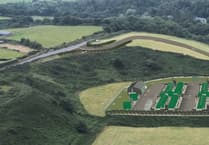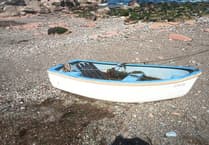Frances Coakley was billed as ’Our Own Manx Notebook Editor’.
She is a longstanding committee member and a popular speaker.
Peel has long been known as ’The Sunset City’, partly because of its location and partly because of its red sandstone buildings and walls.
These pick up and enhance the setting rays of the sun making the city glow.
The talk centred on the development of tourism from the top of Gib Lane toTraie Fogog along the Sunset Path.
It took a long while to prove that this was a public footpath.
It started at the bottom of Stanley Road as shown on the 1868 map that also shows Peveril Terrace with very little other development.
The ’Albert Hall’ was opened by 1904. This was a timber building, originally a Baptist Church from Broadway, Douglas. It survives as part of the car showrooms.
This was a welcome arrival as ’Other buildings are in the possession of religious bodies who do not permit public entertainment’.
In other words, there was now a building for entertainment, including dancing.
Peveril Terrace, built 1840 - intended for long-term lets. They were also only 100 yards from the finest sea bathing on the island.
We learned about the investors in this brief building boom. This also included the construction of the sea wall to protect these buildings on what is a vulnerable stretch when wind and tide provide dramatic waves.
Construction of a longer breakwater resulted in damage to the seawall by changing currents. Large rocks were dumped at the base of the vulnerable section and this survives and is effective in absorbing much of the wave energy.
Robert Archer, a builder, built swimming baths, emphasising that this new facility also included provision for women and children to learn to swim.
This was another ’first’ for Peel and was immensely popular.
Meanwhile, the landowners were doing their best to prevent the public walking over the headland.
In 1887, the commissioners organised what we would now call a mass trespass. Three hundred men, women and children took part.
Would the commissioners do this now? The landowner threatened to sue. Mylchreest, the Diamond King put up £20 to fight the case as he remembered walking this path as a boy.
In May 1889, there was a two-day hearing that the town won.
The town band led a celebratory procession to the Creg Malin.
We were led through successive years with a variety of military use of the headland including a protective gun battery.
A Co-op holiday camp was commandeered in 1916 by the War Office for the internment of aliens.
This was later used as a hospital in the Second World War.
The remaining head land was acquired by the commissioners who established a swimming pool, tennis courts and a bowling green.
The next meeting is at 7.30pm on Wednesday, June 19, in the Centenary Centre.
Nicky Bryan, from a long line of movers and shifters, recounts how his family has been moving people since the 1700s!
John Slater





Comments
This article has no comments yet. Be the first to leave a comment.